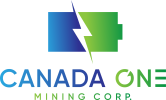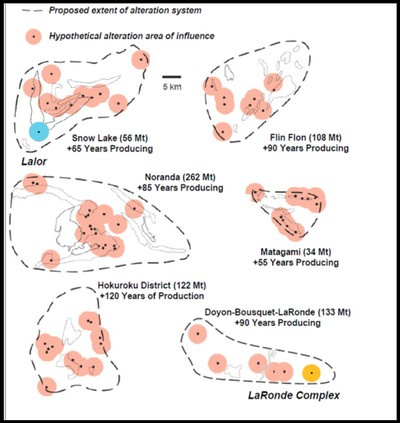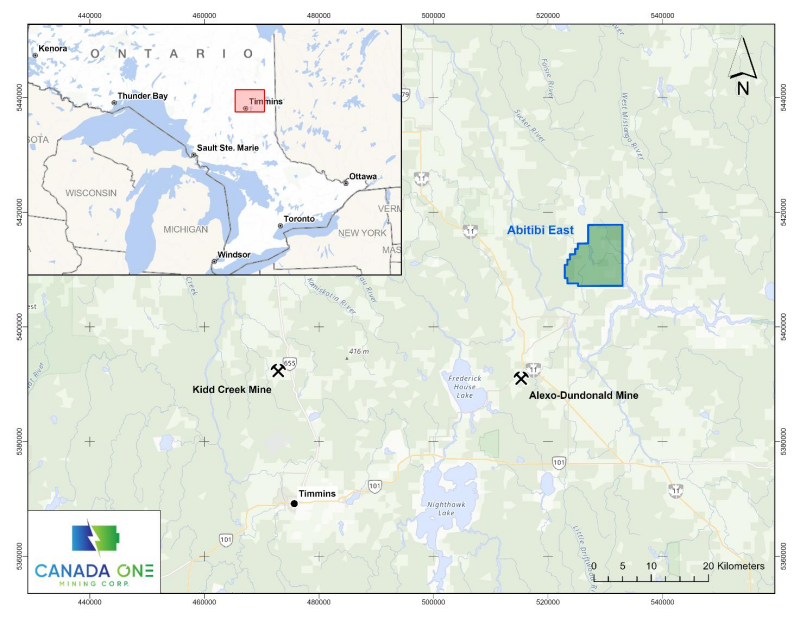 | |||||||||
 |  |  |  | ||||||
Vancouver, B.C. - TheNewswire - November 02, 2023 - Canada One Mining Corp. (“Canada One” or the “Company”) (TSXV:CONE) (OTC:COMCF) (FSE:AU31) recently acquired an option to earn up to a 100% interest in the Abitibi East Critical Minerals Project (“Abitibi East” or the “Project” or the “Property”) located 60 kms northeast of the Timmins, Ontario, Canada.
Abitibi East Overview
The Project is located on the western end of the world-class Abitibi greenstone belt, central to the Timmins Mining Camp (119 Moz Au and 337 Moz Ag historical production)1, the Kidd Creek Volcanic Massive Sulphide (VMS) deposit (2.5 Mt Zn, Cu, Ag Proven and Probable)2, and the Alexo-Dundonald nickel deposit (1,254 kt Ni, Cu, Co Indicated)3.
The Project covers several geological units prime for the exploration of a number of deposit types including: (1) copper-zinc VMS (2) nickel-PGE komatiite and (3) orogenic gold.
Abitibi East Highlights
-
Poly-metallic critical mineral property with additional base and precious metal potential (Ni, Cu, Pt, Pd, Au, Zn)
-
Centrally located to the Timmins Mining (Au) Camp (60kms), Alexo-Dundonald (Ni-Cu-Co) deposit (20kms), and the Kidd Creek (Cu-Zn-Pb-Ag) operating mine (50kms)
-
Abitibi East covers 8050 Ha on the western end of the prolific Abitibi greenstone belt
-
No modern exploration since 1997. Past drilling has identified both VMS style and nickel mineralization
-
Historical sampling and assaying did not sample for gold and other critical elements - modern multi-element techniques are required
Figure 1: Abitibi East location map.
Critical Mineral Potential
Komatiite-Associated Nickel
Historical drilling for copper mineralization encountered multiple occurrences of ultramafic peridotite that returned nickel values from 182 ppm Ni to 1760 ppm Ni. The komatiites rocks of the project are part of the fertile Kidd Munro assemblage that hosts the Alexo-Dundonald komatiite-hosted nickel sulfide deposits. Komatiite-hosted deposits represent some of the world’s largest nickel deposits and are commonly higher grade than intrusion-related or lateritic nickel deposits. The peridotites on Abitibi East will be explored using electromagnetic (EM) surveys to delineate areas of massive sulphides. Mafic and Ultramafic rocks delineated by magnetics survey are likely areas for nickel mineralization and will be the focus of further investigation.
Volcanic Massive Sulphides
Most, but not all, significant VMS mining districts are defined by multiple deposits formed from hydrothermal systems coming from a common heat source and a large magmatic fluid system below the sea floor. Subvolcanic intrusions may also supply metals to the VMS hydrothermal systems. VMS camps can be further characterized by having thin, but extensive, units of iron-rich chemical sediment formed from the exhalation of hydrothermal fluids and material. The extensive layers of graphitic-sulfidic sediments noted at Abitibi East may be indicative of this.
The historical drilling (1968) intersected centrally spaced chlorite-pyrite alteration and favourable geochemical zonation. High (Cu/(Cu+Zn))*100 ratio values matched elevated Cu geochemistry and also infers a central position in a VMS system. A target discovered in the southwest area of the project (1968 holes 1W to 5W) is worth further investigation. The nearby Kidd Creek VMS deposit, one of the largest VMS deposits in the world, provides an exploration analogue.
Uno VMS Prospect
The Prospect is a concealed VMS target located in the southwest of the Project and is delineated by a 2,100 m north-south magnetic anomaly covering historic holes drilled. The holes were drilled to test the conductors identified in an earlier geophysical survey. The geochemical ratio (Cu/(Cu+Zn)) *100 provides values from 0 to 100 and is used to estimate the proximity of a drill hole/ sample to the center of a VMS mineral system. The higher numbers show closeness to the Cu-rich center of the mineral system.
The ratios in holes 1W-5W are almost always equal to 100 (low or no zinc). This geochemical signature indicates the drilling was in the copper-rich center of the system. The geochemical numbers are validated by the predominant chlorite-pyrite alteration that occurs in the central part of a VMS system (See Figure 3: Alteration Box). The Uno Prospect extends to the south from the holes 1W to 5W for about 1 km. More exploration is needed to confirm this.
Holes 6W and 7W are drilled 750 m north of holes 1W-5W. The geochemical ratio values are more erratic indicating a greater zinc content and a proximal position in the VMS mineral system. The alteration for 6W and 7W contain descriptions of carbonates reflecting more proximal alteration. Carbonate-chlorite alteration (trend-4) is typically developed adjacent to massive sulfide lenses. Greater concentrations of low-temperature silver minerals are typical on the edges of a VMS mineral system. The strike of the VMS system is estimated to be over 1,500 m. Future exploration would include a ground EM survey over this prospect to better define the mineral system and map possible higher-grade zones prior to drilling.

Figure 4 – This image illustrates various “clusters” of VMS
deposits in VMS Camps within relative proximity.
Precious Metal Potential
Orogenic Gold
There has not seen much gold exploration over the project area however a major gold mineralizing event occurred within these rock types during the Archean at about 2650 million years ago. The timing of this gold event means that it overprinted older nickel and VMS mineralization. The Archean Abitibi Greenstone is heavily endowed with gold mineralization (e.g., Timmins). Geological logs from Abitibi East include many geological descriptions that refer to gold mineralization. Hole WL95-1 randomly intersected 1.5 m of core at about 1 g/t gold on the margin of a strongly serpentinized magnetic peridotite body.
Many highly favourable REDOX fronts and rheological contacts were encountered in the 1968 and the 1995 drilling. Gold assays were not taken in the 1968 drilling likely because of the low gold price at that time (~U$35 @ ounce). Gold assays taken in the 1995 drilling program were sparse. Further gold driven exploration will determine the gold potential at Abitibi East.
Historical Drilling
Seventeen holes were drilled at an average of 128.3 m. Given that the holes were drilled at a dip of minus 45 to 50 degrees, these holes were relatively shallow. The quality of the historical drilling and sampling at Abitibi East is highly variable. A modern 4-acid digest with a large multi-element package analysis is required to best determine the geochemical attributes of the project. Analysis for low-grade gold material (e.g., 2 ppm) in 1968 was limited. Historical exploration records many situations where samples were taken but not assayed, or samples were not taken at all.
However, the geology and past assays were sufficient to allow positive speculation on the potential for orogenic gold (Au), VMS mineralization (Cu,-Zn-Ag), and komatiite-associated nickel potential (Ni-Cu-Co-PGE). Drilling in 1995 was focused on the same geophysical conductors tested in 1968, and neither drill program was directly focused on targeting specific commodities (e.g., gold, nickel, copper, etc.)
References
1 www.digigeodata.com
2 www.miningdataonline.com
3 www.class1nickel.com
Qualified Person
The technical information contained in this news release has been reviewed and approved by Freeman Smith, P.Geo., a Qualified Person for the purposes of National Instrument 43-101.
Contact Us
For further information, interested parties are encouraged to visit the Company’s website at www.canadaonemining.com, or contact the Company by email at
On behalf of the Board of Directors of
CANADA ONE MINING CORP.
Peter Berdusco
President and Chief Executive Officer
Forward-Looking Statements
This press release includes certain "forward-looking information" and "forward-looking statements" (collectively "forward-looking statements") within the meaning of applicable Canadian securities legislation. All statements, other than statements of historical fact, included herein, without limitation, statements relating to the future operating or financial performance of the Company, are forward looking statements. Forward-looking statements are frequently, but not always, identified by words such as "expects", "anticipates", "believes", "intends", "estimates", "potential", "possible", and similar expressions, or statements that events, conditions, or results "will", "may", "could", or "should" occur or be achieved. Forward-looking statements in this press release relate to, among other things: statements relating to the successful closing of the Offering and anticipated timing thereof and the intended use of proceeds. Actual future results may differ materially. There can be no assurance that such statements will prove to be accurate, and actual results and future events could differ materially from those anticipated in such statements. Forward looking statements reflect the beliefs, opinions and projections on the date the statements are made and are based upon a number of assumptions and estimates that, while considered reasonable by the respective parties, are inherently subject to significant business, technical, economic, and competitive uncertainties and contingencies. Many factors, both known and unknown, could cause actual results, performance or achievements to be materially different from the results, performance or achievements that are or may be expressed or implied by such forward-looking statements and the parties have made assumptions and estimates based on or related to many of these factors. Such factors include, without limitation: the timing, completion and delivery of the referenced assessments and analysis. Readers should not place undue reliance on the forward-looking statements and information contained in this news release concerning these times. Except as required by law, the Company does not assume any obligation to update the forward-looking statements of beliefs, opinions, projections, or other factors, should they change, except as required by law.
TSX Venture Exchange Disclaimer
Neither the TSX Venture Exchange nor its Regulation Services Provider (as that term is defined in the policies of the TSX Venture Exchange) accepts responsibility for the adequacy or accuracy of this release.
Copyright (c) 2023 TheNewswire - All rights reserved.


